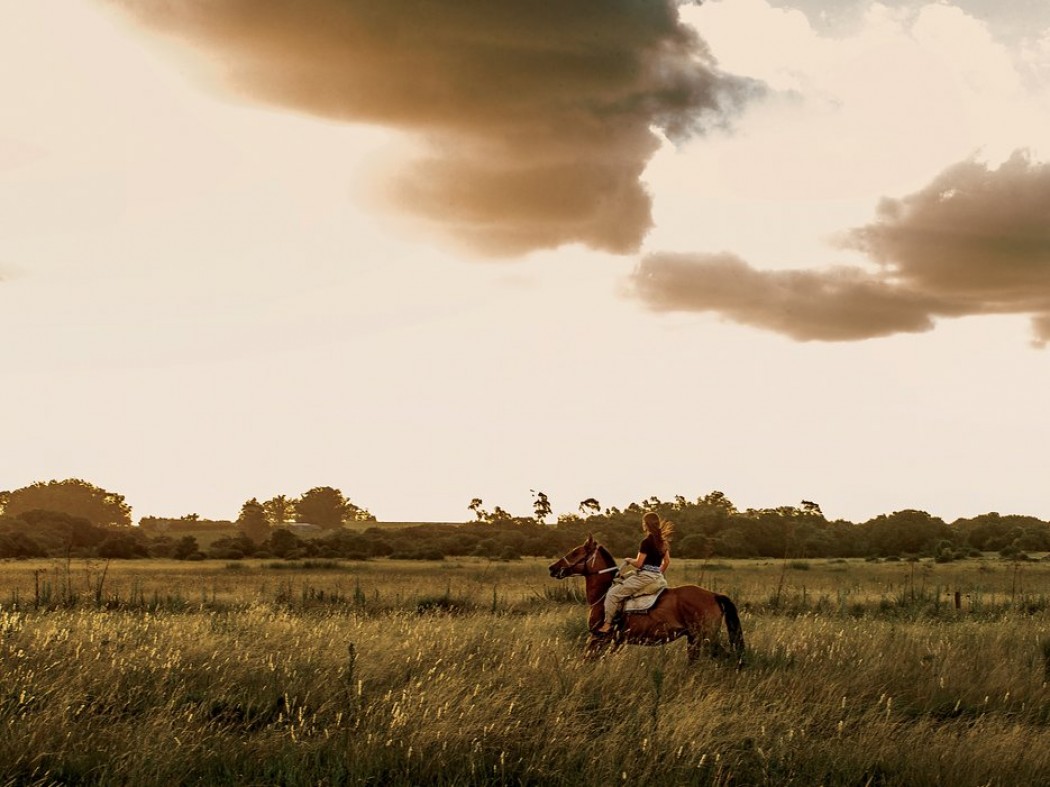Written by Paul Brady August 18, 2015
Eaches of Uruguay’s coast, raw landscapes and unspoiled beaches have made Rocha the ultimate remote hideaway. Question is, can it hold out against the encroaching modern world?
Nico Mendez, with water rushing past his thighs, kept turning to make sure I wasn’t being swept down the Arroyo Valizas and out to sea. I’d met him a few hours earlier at a gas station outside José Ignacio, which felt exactly as sketchy as it sounds—even though Nico greeted me with a beaming smile, the sort you’d expect from a sun-bronzed guide who makes his living scampering across the lonely dunes of eastern Uruguay. We hoped to make it to the town of Cabo Polonio, a sparsely populated coastal outpost with no electricity or running water, in time for lunch. But before that, we had to cross the arroyo. Now, as the sandy bottom seemed to wobble beneath my feet, I glanced up to meet Nico’s concerned gaze and wondered, How did I end up here, anyway?For many travelers to South America, Uruguay is a side trip from Buenos Aires, easily reached by the fast ferries that land in the gorgeously frozen-in-amber town of Colonia del Sacramento. The capital city of Montevideo, meanwhile, is a popular port of call for cruises around Cape Horn. Passengers often have only enough time to explore Montevideo’s compact and crumbling Old City, perhaps try grilled morcilla(blood sausage) at the touristy Mercado del Puerto, and walk the waterfront ramblathat snakes along the Río de la Plata. A few might venture eastward to Punta del Este, an antipodal Miami that roars to life between Christmas and mid-January.
What lies beyond—in a country the size of Oklahoma—remains largely a mystery. But in recent years, a growing number of cognoscenti are discovering the more distant shores northeast of Punta del Este, drawn by whispers of deserted beaches and the charming rusticity that results when Uruguay’s gaucho tradition of self-reliance meets beachfront nonchalance. The gateway to the region is José Ignacio, whose global profile has grown exponentially. Less than a decade ago, few people had heard of the elegant hamlet, just 20 miles northeast of Punta; today, you can buy José Ignacio Vodka in the duty-free shop at Montevideo’s Carrasco International Airport.
Buoyed by the opening of luxury hotels and some of the country’s hottest restaurants, the town turned international brand is now fully on the radar, and entirely worthy of the hype. But it has also become a base camp for forays even farther northeast into Uruguay’s raw and beautiful state of Rocha. The trickle of visitors there may soon become a flood, thanks to a new bridge, designed by Uruguayan architect Rafael Viñoly; set for completion in 2016, it will make some corners of Rocha much easier to reach.
The open question, I discovered on a visit earlier this year, is whether the bridge—and fast-moving development in the fragile ecosystems along this rugged coast—will spoil the raw beauty that makes Rocha one of the world’s last great wild frontiers.
“People here keep moving east, east, east,” said Paola Perelli, an Uruguayan whose company, Lares, has been operating tours in Rocha since 2003, when many of its beachside villages would’ve considered hundreds of visitors—not tens of thousands—a crush. “After the bridge is finished, there are some lonely areas that will grow a lot.”
As we sipped cinnamon-and-basil agua frescain the courtyard of Café Doméstico, on José Ignacio’s main square, Perelli recounted the region’s transformation over the last 12 years. Better infrastructure—including an airport, also designed by Viñoly, that’s less than two hours by car from José Ignacio—has made the eastern beaches more accessible. Now, the crowds moving the scene beyond Punta aren’t just Uruguayans, Argentines, and Brazilians: North Americans, too, have discovered these blissful shores.
Photo by Matthieu Salvaing
I met one in Tarajia Morrell, a former restaurant publicist who left Manhattan in 2014 for a temporary gig working at La Susana, a beachfront restaurant at the edge of José Ignacio. (It’s right next to Bahía Vik, a 37-suite retreat that appeared on Condé Nast Traveler’s Hot List of the world’s best new properties in May.)
Morrell was looking to get away from the hectic city pace, she said, to “turn my life inside out”—and by all evidence she did. Even during her busiest restaurant shifts, she can sneak away for a dive into the sea, just over the dunes from the kitchen. But when she started posting envy-inducing photos on Instagram (#cevichegirl) in the midst of a brutal New York City winter, friends back home began making plans to follow in her sandy footsteps. Thanks to the social-media feedback loop, a loose network of East Coast restaurateurs, hoteliers, and stylists soon washed ashore, in search of what one friend of Morrell’s described as “the intangible magic” and “floaty, energizing light” that envelop the Uruguayan coast.
This past summer was by far the busiest in memory, according to Isabella Channing, an Uruguayan-American yoga instructor who also has a popular studio in Bridgehampton, New York. Channing has been visiting José Ignacio for years with her Uruguayan husband, Marcelo Betancourt, executive chef for the Vik Retreats’ Uruguayan properties. Lately she’s noticed more and more American visitors at Posada Paradiso, a bobo-chic lodge just blocks from the beach, and at Marismo, the stylishly casual restaurant hidden in a candlelit grove of scrub a few minutes’ drive outside town.
The region’s global profile is quantified in real estate prices, with beachfront homes now selling for millions of dollars. A map I picked up at Bahía Vik listed nearly as many José Ignacio real estate brokerages (11) as restaurants (16). On one block, two real estate offices are right next door to each other. Eight miles northeast of José Ignacio, where the Atlantic floods in, the rusting hulk of a barge still ferries cars and bikes and pedestrians across Laguna Garzón. During high season—early December through March—it’s not uncommon to wait 30 minutes to make the three-minute crossing. (This is not a country obsessed with efficiency, and life in Rocha is even more languorous than elsewhere.)
The shores of Rocha are so distant that, bridge or no bridge, they may remain beyond the reach of all but the most determined travelers.
For now, the only way around the lagoon is a 14-mile detour over bumpy gravel farm roads and the more northerly paved Route 9. Hence the new bridge, which will do a great deal to smooth the commute—and make it particularly easy to combine a stay in José Ignacio with forays to the east.
Photo by Matthieu Salvaing
Plans call for a roundabout-style span that’s actually designed to slow traffic, but many here are skeptical. “The bridge is a huge mistake,” said Manuel De Castro, caretaker of the Laguna Garzón Lodge this past season. The waterfront property, which consists of a dozen floating cabañasconnected to the shore by wooden walkways, will be near the bridge’s eastern landing. It has much at stake as crowds move ever eastward.
Yes, more visitors would mean more guests spending the night, De Castro admitted, but in creased traffic “will destroy the tranquillity that defines this place.” For the moment, there’s little to do beyond bird-watching, paddling a kayak, or hiking to a beach where a pair of surfers might be the only other people in sight. It is not the sort of place that would be improved by thousands of cars whizzing past.
I first visited eastern Uruguay in early 2008 as the season was drawing to a close. On a friend’s advice, I ventured past Punta del Este and José Ignacio to the frontier town of Punta del Diablo, which had started to catch the attention of backpackers making their way from São Paulo to Buenos Aires. About 100 miles northeast of José Ignacio and just 25 miles from the border of Brazil, the town offered little beyond endless stretches of empty sand, fried fish empanadas, and sandy-floor hangouts with Patricia lager served by the liter. It was perfect.
Since then, Punta del Diablo and other coastal towns here—La Paloma, La Pedrera, Aguas Dulces, Barra de Valizas—have grown considerably and lost a bit of their edge along the way. (The installation of an ATM in Punta del Diablo was considered a giant leap forward.) But they remain more rugged versions of José Ignacio—places where Montevideans rent small cabins and spend weeks on the beach, cooking grass-fed rib eye over hardwood and dancing at impromptu parties deep into moonlit nights.
Photo by Matthieu Salvaing
The shores of Rocha are so distant that, bridge or no bridge, they may remain beyond the reach of all but the most determined travelers. Sure, there are inklings of a different world to come: Hotels have popped up where there’d been nothing but scrub grass, and new restaurants with ambitious menus—handmade pasta! actual wine lists!—offer alternatives to the basic-butdelicious chivitos (steak sandwiches) I remembered. But during my most recent trip, at the peak of high season, the main thing missing in Rocha was…everyone else.
“At one point, two years ago, about 30 hotels and hostels had opened in Punta del Diablo,” said Brian Meissner, a Wisconsinite who helped put the town on the tourist map when he built the guesthouse El Diablo Tranquilo in 2007. “But by January of this year, we were down to 11 in what should be high season. Many of the restaurants, including ours, just couldn’t make it.” The frontier, in short, hasn’t yet been overrun. “What sets Uruguay apart is that it has recognized that success in tourism doesn’t mean towns grow 100 percent every year,” Meissner said. Instead, strict controls on building—and a small number of landowners willing to sell lots—have kept devel opment from running out of control. And for now, Meissner said, increased accessibility has not impinged on “the character that makes this country—or at least the towns in Rocha—such a desirable place to be.” After all, he added, “part of the charm remains the inherent inconvenience.”
When it comes to inaccessibility, Cabo Polonio is world-class. There are only two ways to reach the remote village: a five-mile hike like the one that had Nico and me wading waist-deep through the arroyo, or a 30-minute ride in a four-by-four truck (piloted by a local driver) that careens, Mad Max–style, over the dunes and along the coast.
Photo by Matthieu Salvaing
The intrepid are rewarded. When Nico and I finally arrived in Cabo Polonio, hungry and sun-burned, we stopped at a no-name café—one of many that pop up during high season—and ordered platters of fresh-caught sole, seared on a flattop grill and served with hunks of lemon, along with some impossibly cold Patricia. We could’ve stayed for months, blissfully marooned in a frontier town on a remote cape in rural South America, insulated from a world where overdevel opment can feel inevitable and Instagram over sharing can spoil even the bestkept secrets—a wild place where nothing stands between you and the sand, the sky, and the everconstant salt breeze off the ocean.
Fuente: http://www.cntraveler.com/
Foto: Matthieu Salvaing
Video: The SceneRELATED CONTENT
Photos: The Hidden Beauty of Uruguay’s Eastern Shores
BEST TIME TO GO
South American summer—early December through March (prices are high and crowds thick around Christmas and Holy Week). Many restaurants, bars, and shops open seasonally; confirm reservations far in advance if you’re visiting April through November.
FLIGHTS
Nonstop from Miami to Montevideo on American Airlines (José Ignacio is about a two-hour drive east of the capital). There are frequent 45-minute flights from Buenos Aires to Montevideo (there’s also a 2.25-hour Buquebus ferry between the two cities). Copa and LAN airlines have one-stop connections to Montevideo through Panama City and Santiago, respectively.
VISAS
None needed with a valid U.S. passport.
DRIVING
Main highways are in excellent shape; in the countryside you might encounter gravel or dirt roads, but these are relatively well maintained. Basic rental cars have manual transmissions—expect to pay about $50 a day more for an automatic. Your vehicle should come equipped with a transponder that allows you to use speedier drive-through toll lanes, similar to E-Z Pass in the United States. Fuel is expensive by U.S. standards—about $5.60 a gallon, though it’s measured in liters.
TAXIS
Nonexistent. And recently passed legislation makes Uruguay’s tolerance for drunk driving effectively zero—meaning a designated driver should skip cocktails altogether.
TRAVEL SPECIALISTS
Paola Perelli, based in Uruguay, can arrange tours, hikes, horseback riding, kayaking, windsurfing, and more. Her company, Lares, recently opened a ranch a short drive from José Ignacio, with many of these activities and a rustic restaurant that hosts large-format asados, or barbecues (larestours.com; $95 per person per day). Nico Mendez leads hikes—including the five-mile trek between Barra de Valizas and Cabo Polonio—as well as surf trips throughout Rocha (discoverrocha.org; $200 per day for up to two people).


